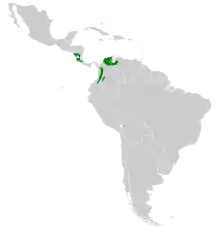Steely-vented hummingbird
The steely-vented hummingbird (Saucerottia saucerottei) is a medium-sized hummingbird that is a resident breeder from Colombia and northwestern Venezuela. The Central American birds differ in voice and behaviour from those in South America and may be a separate species, the blue-vented hummingbird (S. hoffmanni).
| Steely-vented hummingbird | |
|---|---|
_1.jpg.webp) | |
| Scientific classification | |
| Kingdom: | Animalia |
| Phylum: | Chordata |
| Class: | Aves |
| Order: | Apodiformes |
| Family: | Trochilidae |
| Genus: | Saucerottia |
| Species: | S. saucerottei |
| Binomial name | |
| Saucerottia saucerottei | |
 | |
| Range of S. saucerrottei Year-round range | |
| Synonyms | |
|
Saucerottia saucerrottei | |
Taxonomy
This species was formerly placed in the genus Amazilia. A molecular phylogenetic study published in 2014 found that the genus Amazilia was polyphyletic.[2] In the revised classification to create monophyletic genera, the steely-vented hummingbird was moved to the resurrected genus Saucerottia.[3][4]
Description
The steely-vented hummingbird is 9 cm (3.5 in) long and weighs 4.5 g (0.16 oz). It is mainly bronze-green above, becoming more bronze on the wing, lower back and rump, and has a blue-black tail. The male has glittering green underparts, white thighs and a blue vent. The female is duller green below and has grey-buff edges to the vent feathers. Young birds are dull dark bronze-green below.
The steely-vented hummingbird has a trilled descending chit call in South America, but the Blue-vented from Central America has a high sharp tsip. The male's song in Costa Rica is a buzzy bzz WEEP wup.
Distribution and habitat
This hummingbird inhabits open woodland such as second growth, coffee plantations, gardens, savanna, and the edges and gaps of evergreen forests. It occurs from sea level up to 1,800 m (5,900 ft).
Behaviour
The nest is a cup of plant down and cobwebs, decorated outside with lichen and placed on a small outside twig 2–7 m (6.6–23.0 ft) high in a small tree. The female alone incubates the two white eggs.
This hummingbird feeds at many types of flowers, including epiphytes and Heliconias, and both sexes are aggressive and territorial, defending favoured areas.
References
- BirdLife International (2012). "Amazilia saucerrottei". IUCN Red List of Threatened Species. 2012. Retrieved 26 November 2013.CS1 maint: ref=harv (link)
- McGuire, J.; Witt, C.; Remsen, J.V.; Corl, A.; Rabosky, D.; Altshuler, D.; Dudley, R. (2014). "Molecular phylogenetics and the diversification of hummingbirds". Current Biology. 24 (8): 910–916. doi:10.1016/j.cub.2014.03.016.
- Stiles, F.G.; Remsen, J.V. Jr.; Mcguire, J.A. (2017). "The generic classification of the Trochilini (Aves: Trochilidae): Reconciling taxonomy with phylogeny". Zootaxa. 4353 (3): 401–424. doi:10.11646/zootaxa.4353.3.
- Gill, Frank; Donsker, David; Rasmussen, Pamela, eds. (July 2020). "Hummingbirds". IOC World Bird List Version 10.2. International Ornithologists' Union. Retrieved 8 January 2020.
External links
| Wikimedia Commons has media related to Amazilia saucerrottei. |
| Wikispecies has information related to Amazilia saucerrottei. |
- "Amazilia saucerrottei". Avibase.

- "Steely-vented hummingbird media". Internet Bird Collection.
- Steely-vented hummingbird photo gallery at VIREO (Drexel University)
- Steely-vented hummingbird species account at Neotropical Birds (Cornell Lab of Ornithology)
